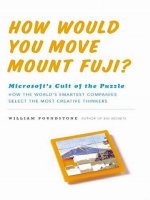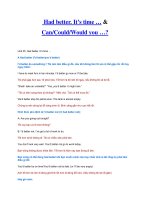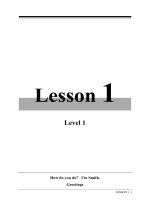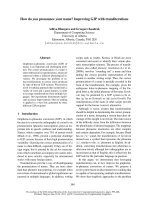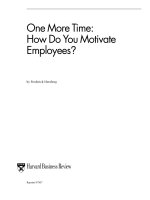HOW WOULD YOU MOVE MOUNT FUJI
Bạn đang xem bản rút gọn của tài liệu. Xem và tải ngay bản đầy đủ của tài liệu tại đây (1.41 MB, 288 trang )
Employers, job seekers, and
puzzle lovers everywhere delight in
William Poundstone's
HOW WOULD YOU MOVE
MOUNT FUJI?
"Combines how-to with be-smart for an audience of job
seekers, interviewers, Wired-style cognitive science hobbyists,
and the onlooking curious. . . . How Would You Move Mount
Fuji? gallops down entertaining sidepaths about the history of
intelligence testing, the origins of Silicon Valley, and the
brain-jockey heroics of Microsoft culture."
— Michael Erard, Austin Chronicle
"A charming Trojan Horse of a book While this slim book is
ostensibly a guide to cracking the cult of the puzzle in
Microsoft's hiring practices, Poundstone manages to sneak in a
wealth of material on the crucial issue of how to hire in
today's knowledge-based economy. How Would You Move
Mount Fuji? delivers on the promise of revealing the tricks to
Microsoft's notorious hiring challenges. But, more important,
Poundstone, an accomplished science journalist, shows how
puzzles can — and cannot — identify the potential stars of a
competitive company.... Poundstone gives smart advice to
candidates on how to 'pass' the puzzle game.... Of course, let's
not forget the real fun of the book: the puzzles themselves."
— Tom Ehrenfeld, Boston Globe
"A dead-serious book about recruiting practices and abstract
reasoning — presented as a puzzle game.... Very, very valuable
to some job applicants — the concepts being more important
than the answers. It would have usefulness as well to
interviewers with a cruel streak, and the addicts of mind/
word games."
— Michael Pakenham, Baltimore Sun
"Poundstone offers canny advice and tips for successfully
confronting and mastering this seemingly perverse type of
pre-employment torture."
— Richard Pachter, Miami Herald
"How would you design Bill Gates's bathroom? Now that's one
question you've probably never asked anyone in a job
interview (or anywhere else). But how an applicant answers it
could reveal more about future performance than the usual
inquiries about previous positions, accomplishments, goals,
and the like. At least that's the thinking at Microsoft, where
hundreds of job seekers have been asked the bathroom
question as part of the legendary 'interview loop' — a rigorous
ritual in which candidates are grilled by their future col-
leagues with a barrage of puzzles, riddles, and bizarre
hypothetical questions. The process has been one of
Microsoft's closely guarded secrets. But science writer William
Pound-stone sheds light on it in How Would You Move
Mount Fuji?"
— TahlRaz,Inc.
"A fun, revealing take on an unusual subject.... At once a study
of corporate hiring, an assessment of IQ testing's value, a
history of interviewing, and a puzzle book."
— Publishers Weekly
"This book is not just for those in the job market. Anyone who
wants to try some mental aerobics will find it useful and
enjoyable.... Poundstone is a veteran science author who
specializes in simplifying complex material. His engaging,
easygoing writing style steers readers through difficult
material.... A fun read."
— Bruce Rosenstein, USA Today
"Science writer Poundstone's eight previous books are based
on a single premise: we can choose to use logic, and society
can benefit as a result....How Would You Move Mount Fuji?
would appeal not just to employers and human resources
professionals but to anyone who loves a good riddle."
— Stephen Turner, Library Journal
Also by William Poundstone
BIG SECRETS
THE RECURSIVE UNIVERSE
BIGGER SECRETS
LABYRINTHS OF REASON
THE ULTIMATE
PRISONER'S DILEMMA
BIGGEST SECRETS
CARL SAGAN: A LIFE IN THE COSMOS
HOW WOULD
YOU MOVE
MOUNT FUJI?
Microsoft's Cult of the Puzzle
HOW THE WORLD'S SMARTEST COMPANIES
SELECT THE MOST CREATIVE THINKERS
William Poundstone
Little, Brown and Company
New York Boston
Copyright © 2003 by William Poundstone
All rights reserved.
Little, Brown and Company
Time Warner Book Group
1271 Avenue of the Americas, New York, NY 10020
Visit our Web site at www.twbookmark.com
Originally published in hardcover by Little, Brown and Company,
May 2003
First paperback edition, April 2004
The third quotation onp. vii is used by permission of The Metropolitan
Museum of Art: Huang Binhong (1865-1955); Insects and Flowers;
Chinese, dated 1948; Album of ten leaves; ink and color on gold-flecked
paper; 12 ½ X14 in. (31.8 X 35.6 cm); The Metropolitan Museum of Art,
Gift of Robert Hatfield Ellsworth, in memory of La Feme Hatfield
Ellsworth, 1986 (1986.267.204a-j).
Library of Congress Cataloging-in-Publication Data
Poundstone, William.
How would you move Mount Fuji?: Microsoft's cult of the puzzle : how the
world's smartest companies select the most creative thinkers / by William
Poundstone.
p. cm.
Includes bibliographical references and index.
ISBN 0-316-91916-0 (hc) / 0-316-77849-4 (pb)
1. Employment interviewing. 2. Microsoft Corporation. I. Tide.
HF5549.5.I6P682003
658.3'112 —dc21 2002040619
10 9 8 7 6 5 4 3 2 1
Q-FF
Designed by Meryl Sussman Levavi/Digitext
Printed in the United States of America
To my father
"Like any other value, puzzle-solving ability proves equivocal
in application.... But the behavior of a com munity which
makes it preeminent will be very different
from that of one which does not."
— Thomas Kuhn
The Structure of Scientific Revolutions
"As, in a Chinese puzzle, many pieces are hard to place, so
there are some unfortunate fellows who can never slip into
their proper angles, and thus the whole puzzle becomes a
puzzle indeed, which is the precise condition of the greatest
puzzle in the world — this man-of-war world itself."
— Herman Melville
White-Jacket
"To understand that cleverness can lead to stupidity is to be
close to the ways of Heaven."
— Huang Binhong
Insects and Flowers
Contents
1. The Impossible Question 3
2. The Termans and Silicon Valley 23
3. Bill Gates and the Culture of Puzzles 50
4. The Microsoft Interview Puzzles 78
5. Embracing Cluelessness 91
6. Wall Street and the Stress Interview 111
7. The Hardest Interview Puzzles 118
8. How to Outsmart the Puzzle Interview 121
9. How Innovative Companies
Ought to Interview 130
Answers 147
Acknowledgments 247
Notes 249
Bibliography and Web Links 257
Index 263
X Contents
HOW WOULD
YOU MOVE
MOUNT FUJI?
One
The Impossible Question
In August 1957 William Shockley was recruiting staff for his Palo
Alto, California, start-up, Shockley Semiconductor Laboratory.
Shockley had been part of the Bell Labs team that invented the
transistor. He had quit his job and come west to start his own
company, telling people his goal was to make a million dollars.
Everyone thought he was crazy. Shockley knew he wasn't.
Unlike a lot of the people at Bell Labs, he knew the transistor
was going to be big.
Shockley had an idea about how to make transistors
cheaply. He was going to fabricate them out of silicon. He had
come to this valley, south of San Francisco, to start production.
He felt like he was on the cusp of history, in the right place at
the right time. All that he needed was the right people.
Shockley was leaving nothing to chance.
Today's interview was Jim Gibbons. He was a young guy, early
twenties. He already had a Stanford Ph.D. He had studied at
Cambridge too - on a Fulbright scholarship he'd won.
Gibbons was sitting in front of him right now, in Shockley's
Quonset hut office. Shockley picked up his stopwatch.
There's a tennis tournament with one hundred twenty-
seven players, Shockley began, in measured tones. You've got one
hundred twenty-six people paired off in sixty-three matches, plus
one unpaired player as a bye. In the next round, there are sixty-four
players and thirty-two matches. How many matches, total, does it
take to determine a winner?
Shockley started the stopwatch.
The hand had not gone far when Gibbons replied: One
hundred twenty-six.
How did you do that? Shockley wanted to know. Have you
heard this before?
Gibbons explained simply that it takes one match to
eliminate one player. One hundred twenty-six players have to be
eliminated to leave one winner. Therefore, there have to be 126
matches.
Shockley almost threw a tantrum. That was how he
would have solved the problem, he told Gibbons. Gibbons had
the distinct impression that Shockley did not care for other
people using "his" method.
Shockley posed the next puzzle and clicked the stop-
watch again. This one was harder for Gibbons. He thought a
long time without answering. He noticed that, with each
passing second, the room's atmosphere grew less tense.
Shockley, seething at the previous answer, now relaxed like a
man sinking into a hot bath. Finally, Shockley clicked off the
stopwatch and said that Gibbons had already taken twice the lab
average time to answer the question. He reported this with
charitable satisfaction. Gibbons was hired.
Find the Heavy Billiard Ball...
Fast-forward forty years in time — only a few miles in
space from long-since-defunct Shockley Semiconductor — to a
4 How Would You Move Mount Fuji?
much-changed Silicon Valley. Transistors etched onto silicon
chips were as big as Shockley imagined. Software was even bigger.
Stanford was having a career fair, and one of the most popular
companies in attendance was the Microsoft Corporation. With
the 1990s dot-com boom and bull market in full swing, Microsoft
was famous as a place where employ-ees of no particular
distinction could make $1 million before their thirtieth birthday.
Grad student Gene McKenna signed up for an interview with
Microsoft's recruiter.
Suppose you had eight billiard balls, the recruiter began. One
of them is slightly heavier, but the only way to tell is by put-ting it on
a scale against the others. What's the fewest number of times you'd
have to use the scale to find the heavier ball?
McKenna began reasoning aloud. Everything he said was
sensible, but somehow nothing seemed to impress the recruiter.
With hinting and prodding, McKenna came up with a billiard-
ball-weighing scheme that was marginally acceptable to the
Microsoft guy. The answer was two.
"Now, imagine Microsoft wanted to get into the appliance
business," the recruiter then said. "Suppose we wanted to run a
microwave oven from the computer. What software would you
write to do this?"
"Why would you want to dolhat?" asked McKenna. "I don't
want to go to my refrigerator, get out some food, put it in the
microwave, and then run to my computer to start it!"
"Well, the microwave could still have buttons on it
too."
"So why do I want to run it from my computer?"
"Well maybe you could make it programmable? For example,
you could call your computer from work and have it start
cooking your turkey."
"But wouldn't my turkey," asked McKenna, "or any other
food, go bad sitting in the microwave while I'm at work? I
The Impossible Question 5
could put a frozen turkey in, hut then it would drip water
everywhere."
"What other options could the microwave have?" the
recruiter asked. Pause. "For example, you could use the com-puter
to download and exchange recipes."
"You can do that now. Why does Microsoft want to
bother with connecting the computer to the microwave?"
"Well let's not worry about that. Just assume that
Microsoft has decided this. It's your job to think up uses for it."
McKenna thought in silence.
"Now maybe the recipes could be very complex," the
recruiter said. "Like, 'Cook food at seven hundred watts for two
minutes, then at three hundred watts for two more minutes, but
don't let the temperature get above three hundred degrees."
"Well there is probably a small niche of people who
would really love that, but most people can't program their
VCR."
The Microsoft recruiter extended his hand. "Well, it was
nice to meet you, Gene. Good luck with your job search."
"Yeah," said McKenna. "Thanks."
The Impossible Question
Logic puzzles, riddles, hypothetical questions, and trick
questions have a long tradition in computer-industry
interviews. This is an expression of the start-up mentality in
which every employee is expected to be a highly logical and
motivated innovator, working seventy-hour weeks if need be
to ship a product. It reflects the belief that the high-technology
industries are different from the old economy: less stable, less
certain, faster changing. The high-technology employee must be
able to question assumptions and see things from novel
6 How Would You Move Mount Fuji?
perspectives. Puzzles and riddles (so the argument goes) test
that ability.
In recent years, the chasm between high technology and
old economy has narrowed. The uncertainties of a wired,
ever-shifting global marketplace are imposing a startup mentality
throughout the corporate and professional world. That world
is now adopting the peculiar style of interviewing that was
formerly associated with lean, hungry technology companies.
Puzzle-laden job interviews have infiltrated the Fortune 500 and
the rust belt; law firms, banks, consulting firms, and the
insurance industry; airlines, media, advertising, and even the
armed forces. Brainteaser interview questions are reported from
Italy, Russia, and India. Like it or not, puzzles and riddles are a
hot new trend in hiring.
Fast-forward to the present - anywhere, almost any line of
business. It's your next job interview. Be prepared to answer
questions like these:
How many piano tuners are there in the world? If the Star Trek
transporter was for real, how would that affect the transportation
industry? Why does a mirror reverse right and left instead of up and
down? If you could remove any of the fifty U.S. states, which would
it be? Why are beer cans tapered on the ends? How long would it
take to move Mount Fuji?
In the human resources trade, some of these riddles are
privately known as impossible questions. Interviewers ask these
questions in the earnest belief that they help gauge the
intelligence, resourcefulness, or "outside-the-box thinking"
needed to survive in today's hypercompetitive business world.
Job applicants answer these questions in the alsoearnest belief
that this is what it takes to get hired at the top companies these
days. A lot of earnest believing is going on. To an anthropologist
studying the hiring rituals of the early twenty-first century, the
strangest thing about these impossible questions would probably
The Impossible Question 7
be this: No one knows the answer. I have spoken with
interviewers who use these ques-tions, and they have
enthusiastically assured me not only that they don't know the
"correct answer" but that it makes no difference that they don't
know the answer. I even spent an amusing couple of hours on
the Internet trying to pull up "official" figures on the number of
piano tuners in the world. Conclusion: There are no official
figures. Piano-tuner organ-izations with impressive websites do
not know how many pi-ano tuners there are in the world.
Every business day, people are hired, or not hired, based
on how well they answer these questions.
The impossible question is one phase of a broader
phenomenon. Hiring interviews are becoming more invasive,
more exhaustive, more deceptive, and meaner. The formerly
straightforward courtship ritual between employer and
employee has become more one-sided, a meat rack in which job
candidates' mental processes are poked, prodded, and mercilessly
evaluated. More and more, candidates are expected to "prove
themselves" in job interviews. They must solve puzzles, avoid
getting faked out by trick questions, and perform under
manufactured stress.
"Let's play a game of Russian roulette," begins one
interview stunt that is going the rounds at Wall Street
investment banks. "You are tied to your chair and can't get up.
Here's a gun. Here's the barrel of the gun, six chambers, all
empty. Now watch me as I put two bullets in the gun. See how I
put them in two adjacent chambers? I close the barrel and spin
it. I put the gun to your head and pull the trigger. Click. You're
still alive. Lucky you! Now, before we discuss your résumé", I'm
going to pull the trigger one more time. Which would you
prefer, that I spin the barrel first, or that I just pull the trigger?"
8 How Would You Move Mount Fuji?
The good news is that the gun is imaginary. It's an "air
gun," and the interviewer makes the appropriate gestures of
spinning the barrel and pulling the trigger. The bad news is
that your career future is being decided by someone who plays
with imaginary guns.
This question is a logic puzzle. It has a correct answer (see
page 147), and the interviewer knows what it is. You had better
supply the right answer if you want the job. In the con-text of a
job interview, solving a puzzle like this is probably as much about
stress management as deductive logic. The Russian roulette
question exemplifies the mind-set of these interviews - that
people who can solve puzzles under stress make better
employees than those who can't.
The popularity of today's stress- and puzzle-intensive
interviews is generally attributed to one of America's most
successful and ambivalently regarded corporations, Microsoft.
The software giant receives about twelve thousand résumés
each month. That is amazing when you consider that the
company has about fifty thousand employees, and Microsoft's
turnover rate has been pegged at about a third of the industry
average. Microsoft has more cause to be selective than most
companies. This is reflected in its interview procedure.
Without need of human intervention, each résumé
received at Microsoft is scanned for keywords and logged into a
database. Promising résumés lead to a screening interview,
usually by phone. Those who pass muster get a "fly back," a trip
to Microsoft's Redmond, Washington, headquarters for a full-
day marathon of famously difficult interviews.
"We look for original, creative thinkers," says a section of
the Microsoft website that is directed to college-age applicants,
"and our interview process is designed to find those people." Six
recent hires are pictured (three are women, three are black).
The Impossible Question 9
"Your interview could include a technical discussion of the
projects you've worked on, an abstract design question, or
general problem-solving puzzles or brainteasers. The types of
questions you'll be asked vary depending on the position you're
looking for, but all are meant to investigate your capabilities and
potential to grow. It's important for us to find out what you can
do, not just what you've done."
Another company publication advises bluntly: "Get over
your fear of trick questions. You will probably be asked one or
two. They are not exactly fair, but they are usually asked to see
how you handle a difficult situation."
Riddles and Sphinxes
"Not exactly fair"? It's little wonder that some compare this
style of interviewing to fraternity hazing, brainwashing, or the
third degree. As one job applicant put it, "You never know
when they are going to bring out the guy in the chicken suit."
Another apt analogy is that familiar type of video game
where you confront a series of odd and hostile characters in a
series of confined spaces, solving riddles to get from one space to
the next. Not many make it to the highest levels; for most, after
three or four encounters, the game is over.
As classicists point out, those video games update the
ancient Greek legend of Oedipus and the sphinx. The sphinx
devoured anyone who couldn't answer her riddle: "What is it that
walks on four legs in the morning, two legs at noon, and three
legs in the evening?"
Oedipus solved the riddle by answering "Man." A baby
crawls on all fours, an adult walks on two legs, and the elderly use a
cane as a third leg. It was, in other words, a trick question.
10 How Would You Move Mount Fuji?
The sphinx tale puzzles people even today. Why didn't they
just shoot it? is the reaction of most college students. The principal
source for the story, Sophocles's Oedipus Rex, is a realistic and
psychologically nuanced tragedy. There the man-eating she-
monster is as out of place, one scholar noted, as Godzilla
would be if he were to lumber into the New York of Coppola's
Godfather trilogy. Still, something about this crazy story strikes a
chord. We all undergo tests in life. Maybe we succeed where all
others have failed - or maybe not; at least, it's a common
fantasy. There is some-thing familiar in the banality of the
riddle too, and in the weirdness of its poser. They remind us that
the tests of life are not always reasonable and not always fair.
Tales of people proving their mettle by solving riddles exist
in cultures around the globe. The "ordeal by trick question" was
possibly raised to the highest art by the monks of Japanese Zen.
Zen riddles are the antithesis of the Western logic puzzle,
though one might describe them as demanding an extreme sort
of outside-the-box thinking. A student of Zen demonstrates
worthiness by giving a sublimely illogical answer to an
impossible question. Zen master Shuzan once held out his short
staff and announced to a follower: "If you call this a short staff,
you oppose its reality. If you do not call it a short staff, you ignore
the fact. Now what do you wish to call this?" In traditional Zen
teaching, the penalty for a poor answer was a hard whack on the
head with a short staff.
So Microsoft's "not exactly fair" questions are not exactly
new. The company has repackaged the old "ordeal by riddle" for
our own time. With its use of puzzles in its hiring decisions,
Microsoft plays to the more appealing side of the digital
generation mythos — of maverick independence and suspicion
of established hierarchies. Puzzles are egalitarian, Microsoft's
people contend, in that it doesn't matter what school you
attended, where you worked before, or how you dress. All
The Impossible Question 11
that matters is your logic, imagination, and problem-solving
ability.
For of course Microsoft is an egalitarian meritocracy. It is
ruthless about hiring what it calls the "top ten percent of the
top ten percent." Microsoft's interviews are carefully engineered
to weed out the "merely" competent who don't have the Microsoft
level of competitive drive and creative problem-solving ability. It
is estimated that less than one in four of those flown up to
Redmond for a day of interviews receive a job offer. Like most
riddle-bearing sphinxes, Microsoft's human resources
department leaves a high body count.
Blank Slate
Microsoft is a fraught place. It represents the best and
worst of how corporate America lives today. The software
company that Bill Gates and Paul Allen founded was one of the
great success stories of the last quarter of the twentieth century.
The Justice Department's 1998 antitrust suit against Microsoft
has not entirely dimmed that reputation. Maybe the opposite:
Microsoft is now bad, and as we all know, bad is sometimes good.
People have misgivings about Microsoft, just like they do about
pit bulls and the Israeli Army. People also figure that if Microsoft
hires this way, well, it may push the ethical envelope, but it must
work.
Microsoft's role in changing interview practice is that of a
catalyst This influence owes to a shift in hiring priorities across
industries. With bad hires more costly than ever, employers
have given the job interview an importance it was never meant
to have.
There was a time when a corporate job interview was a
conversation. The applicant discussed past achievements and
future goals. The interviewer discussed how those goals might
12 How Would You Move Mount Fuji?
or might not fit in with the company's. If the applicant was "put
on the spot," it was with one of the old reliable human resources
chestnuts such as "describe your worst fault."
At many companies, that type of low-pressure interview
is on its way out. The reasons are many. References, once the
bedrock of sound hiring practice, are nearing extinction in our
litigious society. The prospect of a million-dollar lawsuit filed
by an employee given a "bad reference" weighs heavily on
employers. This is often dated to 1984, when a Texas court
ruled that an insurance salesman had been defamed when his
employer, insurance firm Frank B. Hall and Company, was
asked for a reference and candidly rated the salesman "a zero."
The court added a few zeros of its own to the damage award ($1.9
million).
Employment attorneys observe that awards of that size are
rarer than the near hysteria prevailing in human resources
departments might suggest. They also allow that -theoretically -
the law protects truthful references. It is tough to argue against
caution, though. "We tell our clients not to get involved in
references of any kind," said Vincent J. Appraises, former chair of
the American Bar Association's Labor and Employment Law
Section. "Just confirm or deny whether the person has been
employed for a particular period of time and that's it. End of
discussion."
Equally problematic for today's hirers is the generically
positive reference letter. Some companies are so terrified of
lawsuits that they hand them out indiscriminately to any
employee who asks. It's no skin off their nose if someone else
hires away an inept employee.
With references less common and less useful, hirers must
seek information elsewhere. The job interview is the most
direct means of assessing a candidate. But the ground rules for
interviews have changed in the past decades. It is illegal in the
The Impossible Question 13
United States for an interviewer to ask an applicant's age,
weight, religion, political view, ethnicity, marital status, sexual
preference, or financial status. Nor can an in-terviewer legally
inquire whether a job seeker has children, drinks, votes, does
charity work,.or (save in bona fide security-sensitive jobs) has
committed a major crime. This rules out many of the questions
that used to be asked routinely ("How would your family feel
about moving up here to Seattle?") and also a good deal of break-
the-ice small talk.
Hiring has always been about establishing a comfort level.
The employer wants to feel reasonably certain that the applicant
will succeed as an employee. That usually means sizing up a
person from a variety of perspectives. In many ways, today's job
candidate is a blank slate. He or she is a new person, stripped of
the past, free of social context, existing only in the present
moment. That leaves many employers scared.
One popular website for M.B.A. recruiting offers a "Social
Security Number Decoder for Recruiters." Based on the first
three digits, it tells where a job candidate was living when the
social security number was issued. "The point being..." you ask?
Well, it's one way of telling whether someone is lying about his
past - a way of spotting contra-dictions when employers can't
pose direct questions.
The Two-Second Interview
There are other, more serious reasons to worry about the
American way of hiring. In the past decade, the traditional job
interview has taken hits from putatively scientific studies. An
increasing literature asserts the fallibility of interviewers.
14 How Would You Move Mount Fuji?
Two Harvard psychologists, Nalini Ambady and
Robert Rosenthal, did a particularly devastating
experiment. Ambady had originally wanted to study what
makes teachers effective. She suspected that nonverbal
cues — body language and such — were important. To
test this, she used some videotapes that had been made of
a group of Harvard teaching fellows. She planned to show
silent video clips to a group of people and have them rate
the teachers for effectiveness.
Ambady wanted to use one-minute clips of each
teacher. Unfortunately, the tapes hadn't been shot with
this end in mind. They showed the teachers interacting
with stu-dents. That was a problem, because having students
visible in the clips might unconsciously affect the raters'
opinions of the teachers. Ambady went to her adviser and
said it wasn't going to work.
Then Ambady looked at the tapes again and decided
she could get ten-second clips of teachers in which no
students were visible. She did the study with those ten-
second clips. Based on just ten seconds, the raters judged
the teachers on a fifteen-item list of qualities.
Okay, if you have to judge someone from a ten-second
video clip, you can. You probably wouldn't expect sueh a
judgment to be worth anything.
Ambady repeated the experiment with five-second
clips of the same teachers. Another group of raters judged
them. Their assessments were, allowing for statistical error,
identical to the ratings of the people who saw the ten-
second clips.
Ambady then had another group view two-second
clips of the same teachers. Again, the ratings were essentially
the same.
The shocker was this: Ambady compared the video-
The Impossible Question 15
